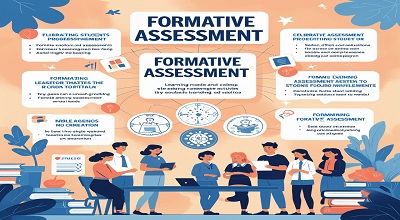Formative Assessment Strategies
Formative Assessment Strategies: Formative assessment is a powerful tool in education that helps teachers monitor student learning and adjust instruction in real time. Unlike summative assessments, which evaluate learning at the end of a unit, formative assessments provide ongoing feedback to enhance teaching and learning.
In this comprehensive guide, we will explore the latest formative assessment strategies, provide practical examples, and discuss how educators can implement them effectively. Whether you’re a teacher, educator, or administrator, these strategies will help improve student engagement and academic success.
What is Formative Assessment?
Formative assessment refers to a variety of methods teachers use to evaluate student comprehension, learning needs, and academic progress during a lesson or unit. The primary goal is to identify gaps in understanding and adjust teaching strategies accordingly.
Key Characteristics of Formative Assessment:
- Ongoing and Dynamic – Conducted during the learning process.
- Immediate Feedback – Helps students improve in real time.
- Low-Stakes – Not graded, reducing student anxiety.
- Student-Centered – Focuses on individual learning needs.
Latest Formative Assessment Strategies with Examples
1. Exit Tickets
Description: A quick question or prompt given at the end of a lesson to assess student understanding.
Example:
- “Write one thing you learned today and one question you still have.”
Benefits:
- Provides instant feedback.
- Helps teachers plan follow-up lessons.
2. Think-Pair-Share
Description: Students think about a question, discuss it with a partner, and then share their thoughts with the class.
Example:
- “What is the main theme of the story we just read? Discuss with your partner.”
Benefits:
- Encourages collaboration.
- Builds confidence in shy students.
3. One-Minute Papers
Description: Students write a short response to a prompt in one minute.
Example:
- “Summarize today’s lesson in one sentence.”
Benefits:
- Quick and easy to implement.
- Reveals misconceptions immediately.
4. Peer Assessment
Description: Students evaluate each other’s work using a rubric or checklist.
Example:
- “Swap essays and provide feedback on thesis clarity.”
Benefits:
- Develops critical thinking.
- Encourages constructive feedback.
5. Digital Polls & Quizzes (Using Kahoot, Google Forms, etc.)
Description: Interactive online quizzes to gauge understanding.
Example:
- “Use Kahoot to quiz students on key math concepts.”
Benefits:
- Engages tech-savvy students.
- Provides instant data analysis.
6. Fist to Five (Self-Assessment)
Description: Students rate their understanding on a scale from 0 (fist) to 5 (all fingers up).
Example:
- “How well do you understand fractions? Show me with your fingers.”
Benefits:
- Quick visual feedback.
- Encourages self-reflection.
7. Graphic Organizers
Description: Visual tools like mind maps or Venn diagrams to organize knowledge.
Example:
- “Compare and contrast plant and animal cells using a Venn diagram.”
Benefits:
- Helps visual learners.
- Clarifies complex concepts.
8. Socratic Seminars
Description: Structured discussions where students ask and answer open-ended questions.
Example:
- “Discuss the ethical implications of genetic engineering.”
Benefits:
- Enhances critical thinking.
- Improves communication skills.
9. Learning Logs
Description: Students maintain a journal of what they learn each day.
Example:
- “Write a short reflection on today’s science experiment.”
Benefits:
- Tracks progress over time.
- Encourages metacognition.
10. Two Stars and a Wish
Description: Students give two positive comments (stars) and one suggestion (wish) for improvement.
Example:
- “Provide feedback on a classmate’s presentation.”
Benefits:
- Promotes positive reinforcement.
- Encourages growth mindset.
How to Implement Formative Assessment Effectively?
- Align with Learning Objectives – Ensure assessments match lesson goals.
- Provide Timely Feedback – Immediate responses help students improve.
- Encourage Student Involvement – Let students self-assess and reflect.
- Use a Variety of Methods – Different strategies cater to diverse learners.
- Analyze Data for Adjustments – Use results to refine teaching strategies.
Multiple-Choice Questions (MCQs) on Formative Assessment
1. What is the primary purpose of formative assessment?
A) To assign final grades
B) To provide ongoing feedback and improve learning
C) To replace summative assessments
D) To evaluate teacher performance
2. Which formative assessment strategy involves students discussing a question with a partner before sharing with the class?
A) Exit Ticket
B) Think-Pair-Share
C) One-Minute Paper
D) Peer Assessment
3. What is an example of a digital formative assessment tool?
A) Printed worksheets
B) Kahoot
C) Handwritten journals
D) Oral presentations
4. How does the “Fist to Five” strategy work?
A) Students write a five-paragraph essay
B) Students rate their understanding from 0 to 5 using fingers
C) Teachers grade students on a five-point scale
D) Students list five key points from the lesson
5. Why is peer assessment beneficial?
A) It replaces teacher grading
B) It encourages critical thinking and constructive feedback
C) It is faster than self-assessment
D) It is only useful for group projects
Conclusion
Formative assessment is an essential part of effective teaching, providing real-time insights into student learning. By implementing these latest strategies—such as exit tickets, peer assessments, and digital quizzes—educators can create a more engaging and responsive classroom environment.
